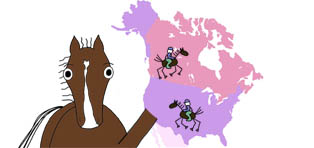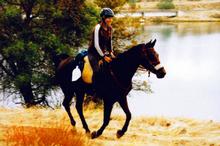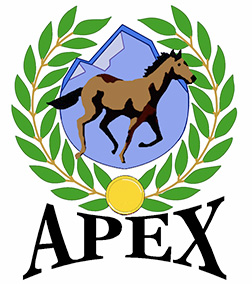Sunday, July 29, 2007

photo: Jeanette Mero of Mariposa holds the reins of her horse Maksymilian as veterinarian Rob Lydon of Menton conducts an examination during Haggin Cup judging Sunday at the Gold Country Fairgrounds. Photo by Philip Wood/Auburn Journal
This year's Tevis Cup made history.
For the first time since the "100 Mile One Day Trail Ride" that starts from Robie Park near Lake Tahoe and ends at Auburn's Gold Country Fairgrounds began in 1955, a paint horse became one of the top-10 finishers.
Pamela Bailie of Pilot Hill and her horse, Skipa Slipa on Ice, finished sixth in the race, arriving in Auburn at 12:05 a.m. Sunday.
"I'm pretty excited," Bailie said Sunday at the awards ceremony for Tevis finishers. "I think it is definitely more rewarding to have the first paint."
Bailie said she took the race one checkpoint at a time, not riding too slow or too fast.
"We just worked our way up," she said. "We had a plan and a time that we wanted to arrive at each checkpoint and we pretty much stuck to it."
John Crandell, 2006's Tevis winner, garnered the 2007 Haggin Cup - which is awarded to one of the top 10 horses that is deemed most healthy - for the second year in row.
Crandell won the cup last year on his horse, Heraldic, and this year on HH Saba Shams.
Crandell arrived in Auburn at 9:45 p.m. Saturday, two minutes behind leader Jeremy Reynolds of Los Gatos.
There was a four-hour time span from the time the first rider finished until the 10th crossed the line at 1:26 a.m.
Reynolds claimed the Tevis Cup but was disqualified from presenting his horse in the Haggin Cup judging after some of his crew members committed traffic violations at the Robinson Flat checkpoint, said Erin Klentos, Tevis ride director.
Reynolds, who arrived in Auburn at 9:43 p.m., was allowed to keep his Tevis win, Klentos said.
"We have rules and we make them very clear to both the rider and the crew," Klentos said. "We want people to understand that even if the crew breaks the rules, it can affect the rider."
Klentos said she did not want to release the specific details about the infractions, but she did say the crew did not obey traffic controls in Robinson Flat, posing a safety threat to other volunteers and other riders. "We still acknowledge the rider," Klentos said. "He did a great job and his horse was excellent. And that is why we chose to allow him to win."
Reynolds didn't offer any specific details either, but he did thank the cup committee.
"I know there are a lot of rumors floating around about what happened," Reynolds said. "I just want to say that the cup committee was very gracious to me. We made a mistake and our crew held us out, but I just want to say thanks to everyone."
The top 10 horses were screened at the fairgrounds Sunday morning and buckles for finishers and the two cups were presented in the afternoon.
Ninety-five riders out of the 185 who started the ride completed it in 24 hours.
That number is not unusual as the completion rate from the past 52 years averages 50 percent, and it doesn't matter if you're a Tevis expert or first-time rider, said Mike Pickett, past president and current treasurer of the Western State Trail Foundation.
"It's a very tough trail," Pickett said. "Even the most prepared riders still run the risk of an unexpected minor injury to their horse."
Horses are pulled out by veterinarians any time at any of the 17 checkpoints - for injuries, lack of hydration and metabolic stability, among other factors.
Three riders received 1,000-mile buckles Sunday and Cassandra Schuler of Petaluma was awarded a 2,000-mile buckle for completing the race 20 times.
"It's a lot of riding," Schuler said. "But I am so grateful to everyone who has ever worked on this ride and those who have crewed for me - which is a lot people. I am hooked on this ride."
The Journal's Jenna Nielsen can be reached at jennan@goldcountrymedia.com or comment at www.auburnjournal.com.







